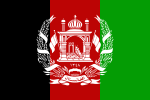Kingdom of Afghanistan
|
Dǝ Afġānistān wākmanān (Pashtun) Pādešāhī-ye Afġānistān (Persian) د افغانستان واکمنان پادشاهي افغانستان Kingdom of Afghanistan 1926–1973 |
|||||
|
|||||
|
|||||
| Motto : | |||||
| Official language |
Pashtun Persian |
||||
| Capital | Kabul | ||||
| Form of government | kingdom | ||||
| Form of government | Constitutional monarchy | ||||
| Head of state |
King Amanullah Khan (1926–1929) Inayatullah Khan (1929) Habibullah Kalakâni (1929) Mohammed Nadir Shah (1929–1933) Mohammed Sahir Shah (1933–1973) |
||||
| Head of government | Prime Minister of Afghanistan | ||||
| surface | 652,225 km² | ||||
| currency |
Afghani Afghan rupee (1929) |
||||
| founding | 1926 (Amanullah Khan is proclaimed King of Afghanistan) | ||||
| resolution | August 24, 1973 (abdication of the king) | ||||
| National anthem |
Royal Hymn (1926–1943) Schāh-e ghayur-o mehrabān-e mā (1943–1973) (Our proud, benevolent King) |
||||
| Time zone | UTC +4.5 (March to October) | ||||
| License Plate | AFG | ||||
| Telephone code | +93 | ||||
| map | |||||

|
|||||
The Kingdom of Afghanistan ( Pashtun د افغانستان واکمنان- Dǝ Afġānistān wākmanān , Persian پادشاهي افغانستان- Pādešāhī-ye Afġānistān ) was a kingdom between Central Asia and South Asia , which existed from 1926 to 1973 on the territory of what is now the Islamic Republic of Afghanistan .
history
The kingdom was founded when the emir of Afghanistan Amanullah Khan of the Baraksai dynasty declared himself padschah (king) in 1926 . On January 14, 1929, he passed the reign to his son Inayatullah Khan , who was overthrown by Habibullah Kalakâni just three days later . However, he was overthrown by Mohammed Nadir Shah in October 1929 with British help and later publicly executed in Kabul . Mohammed Nadir Shah primarily sought proximity to the great powers of the Soviet Union , the United Kingdom and the United States .
Afghanistan joined the League of Nations on November 27, 1934 ; during the Second World War the kingdom remained neutral and joined the United Nations in 1946 .
Mohammed Nadir Shah began a comprehensive reform of the country, which led to conflicts with conservative ulamas . On November 8, 1933, he was murdered by a student in Kabul, whereupon his brothers appointed his son Mohammed Sahir Shah as king, for whom they took over the government until 1953. In 1964, the Loja Dschirga (Great Council Assembly) decided to introduce a new constitution and chose the constitutional monarchy as the form of government . The king continued the reforms, so women got the right to vote and were allowed to attend schools, and the country opened up to the outside world.
While Mohammed Sahir Shah was on a spa stay in Italy, he was overthrown on July 17, 1973 and his cousin and long-time Prime Minister Mohammed Daoud Khan took power with the aim of abolishing the monarchy. On August 24, 1973 the king abdicated and Daoud Khan became the first President of the Republic of Afghanistan .
Individual evidence
- ↑ Barnett Rubin: DĀWŪD KHAN. In: Encyclopædia Iranica . Columbia University , accessed November 26, 2015 .
- ^ History of Afghanistan. (No longer available online.) Archived from the original on September 14, 2015 ; accessed on July 3, 2010 (English). Info: The archive link was inserted automatically and has not yet been checked. Please check the original and archive link according to the instructions and then remove this notice.
literature
- Jan-Heeren Grevemeyer: Afghanistan. Social Change and the State in the 20th Century . VWB, Verlag für Wissenschaft & Bildung, Berlin 1989, ISBN 3-927408-24-7 .
- Karl E. Meyer, Shareen Blair Brysac: Tournament of shadows. The great game and the race for empire in central asia . Counterpoint, Washington DC 1999, ISBN 1-58243-028-4 .
- Philip J. Haythornthwaite: The Colonial Wars Source Book . Arms and Armor, London 1997, ISBN 1-85409-436-X .

